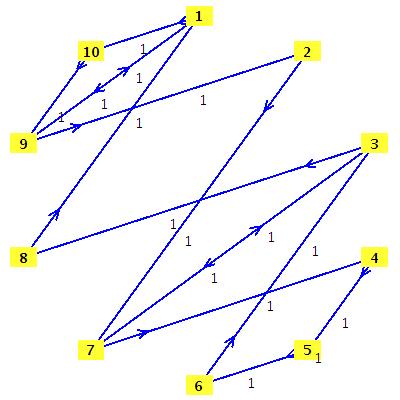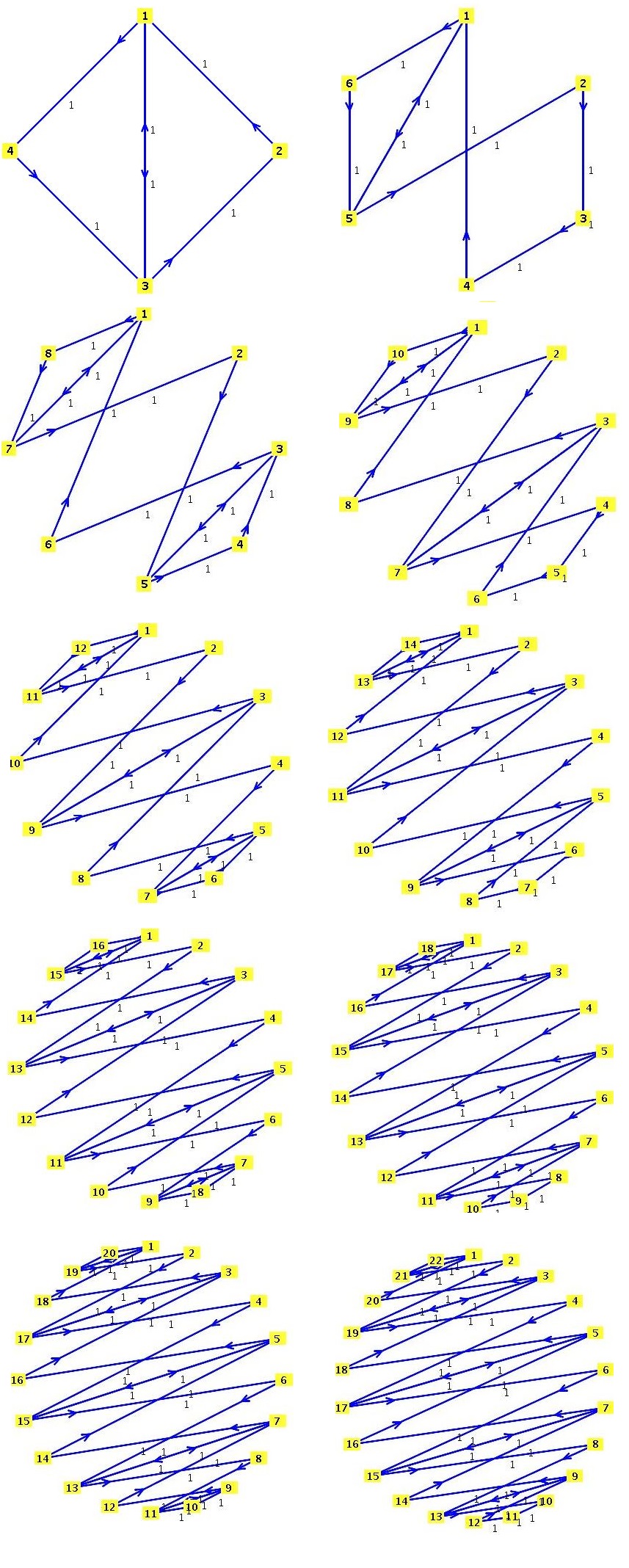Let ${\bf A}_n$ be an $2n \times 2n$ matrix that is defined as follows
$$ {\bf A}_n=\left( \begin{array}{c} 0&0&\cdots&0&0&0&0&1&1\\ 0&0&\cdots&0&0&1&0&0&0\\ 0&0&\cdots&0&0&1&1&0&0\\ 0&0&\cdots&1&0&0&0&0&0\\ \cdots&\cdots&\cdots&\cdots&\cdots&\cdots&\cdots&\cdots&\cdots\\ \cdots&\cdots&\cdots&\cdots&\cdots&\cdots&\cdots&\cdots&\cdots\\ 1&1&\cdots&0&0&0&0&0&0\\ 0&0&\cdots&0&0&0&0&1&0\\ \end{array} \right). $$
For instance, the matrix ${\bf A}_5$ is given by
$$ {\bf A}_5=\left( \begin{array}{cccccccccc} 0&0&0&0&0&0&0&0&1&1\\ 0&0&0&0&0&0&1&0&0&0\\ 0&0&0&0&0&0&1&1&0&0\\ 0&0&0&0&1&0&0&0&0&0\\ 0&0&0&0&1&1&0&0&0&0\\ 0&0&1&0&0&0&0&0&0&0\\ 0&0&1&1&0&0&0&0&0&0\\ 1&0&0&0&0&0&0&0&0&0\\ 1&1&0&0&0&0&0&0&0&0\\ 0&0&0&0&0&0&0&0&1&0 \end{array} \right). $$
My Question: How to show that the $(n+2)$th power of ${\bf A}_n$, denoted by ${\bf A}_n^{n+2}$, is a positive matrix and matrices ${\bf A}_n^{i}$ with $1\leq i \leq n+1$ are not positive matrices?
For instance, it can be checked that ${\bf A}_5^{7}$ is a positive matrix and matrices ${\bf A}_5^{i}$ with $1\leq i \leq 6$ are not positive matrices.
I know this question is related with the concept of primitive matrices and maybe by considering the values of the eigenvalues of ${\bf A}_n$ we can obtain an answer. But I would like to find a combinatorial answer. For example, we can consider ${\bf A}_n$ as an incidence matrixadjacency matrix of a weighted directed graph. Then we should check why there is at least a directed walk between every node of the graph of length $n+2$? The weighted directed graph of ${\bf A}_5$ can be drawn in the following form
It follows from the given graph that there is at least a directed walk between every node of the graph of length $7$. Also, it can be checked that there is no directed walk between the node 4 to the node 2 of length less than seven.
Thanks for any suggestions.
Edition 1:
Consider the following $2\times 2$ matrices
$$ {\bf m}=\left( \begin{array}{c} 1&1 \\ 0&0 \end{array} \right),\quad {\bf n}=\left( \begin{array}{c} 0&0 \\ 1&0 \end{array} \right),\quad {\bf z}=\left( \begin{array}{c} 0&0 \\ 0&0 \end{array} \right). $$ The matrix ${\bf A}_n$ is a type of block-circulant matrices that can be defined as follows:
$$ {\bf A}_n=\left( \begin{array}{c} {\bf z} & {\bf z} &\cdots &{\bf z}& {\bf z}&{\bf n} & {\bf m}\\ {\bf z} & {\bf z} &\cdots & {\bf z}&{\bf n}&{\bf m} & {\bf z}\\ \cdots&\cdots&\cdots&\cdots&\cdots&\cdots&\dots\\ \cdots&\cdots&\cdots&\cdots&\cdots&\cdots&\cdots\\ {\bf n} & {\bf m} &\cdots & {\bf z}&{\bf z}&{\bf z} & {\bf z}\\ {\bf m} & {\bf z} &\cdots & {\bf z}&{\bf z}&{\bf z} & {\bf n} \end{array} \right). $$
From Maple software, the associated graphs with ${\bf A}_i$ with $2\leq i \leq 11$ are provided as follows


